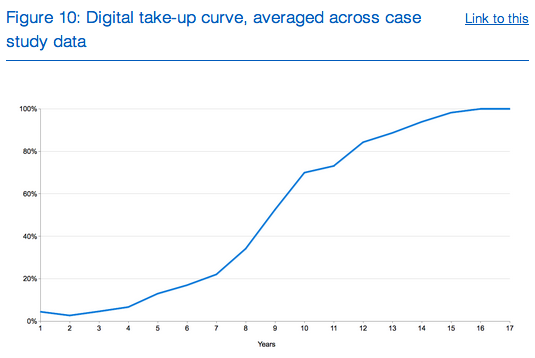One of the best things about well-designed digital services - shopping, banking, booking flights - is how much more efficient they are for users. But an equally big plus of digital is the efficiency benefits for organisations providing those services. And for the government in particular, digital has huge potential to help us provide better services for less money.
Exactly how much less money is the really exciting part. The government spends about £6bn - £9bn on transactional services every year. The Digital Efficiency Report, which we published alongside the Government Digital Strategy, suggests that if we made these services digital by default, the government could save between £1.7 billion - £1.8 billion every year.

This won’t happen straightaway. There is lots of hard work, investment and development needed to make these savings a reality. But digital can make a real difference quickly. The report estimates that over £1.2 billion could be saved through digitisation in this Parliament alone. Some of these savings will help to reduce the deficit. Others will be passed on directly to users in the form of cheaper services.
The Digital Efficiency Report is not the last word on savings from digital services. Our report is based on historic data; examining the savings that have already been gained from going digital. As we see more evidence of the benefits from the government’s new approach to the web, we can revise these estimates - and we expect that revision to be in an upward direction. Alongside this, departments are working on more detailed analysis for the potential efficiency gains from digital services, putting together robust business cases and understanding what needs to be done to unlock real financial benefits.
Alongside the Government Digital Strategy, this work shows that going digital is good news for the public - as service users, and as taxpayers too.

6 comments
Comment by Alastair Macartney posted on
Can the savings assumptions here (e.g. "1% rise in digital take-up produces teh following saving by function") be applied to a local government as well as a central government setting. This would be especially useful in establishing benefits cases in local government
Comment by David Wilks posted on
Similar principles will apply in Local Government, but GDS haven't tried to quantify these benefits. We suggest you approach SOCITM (the Society of IT Management) and ask to see their 2012 report Potential for Channel Shift in Local Government.
Comment by Policy, delivery, Government digital service posted on
[...] Aug: E-petitions birthday Sep: Delivered alpha of Student Loans Company service. Oct: Finalise the Digital Efficiency Report Nov: Release the Govt Digital Strategy and Inside Government, and launched GOV.UK Dec: Three major [...]
Comment by Digital Transformation in 2013: The strategy is delivery. Again. | Government Digital Service posted on
[...] Aug: E-petitions birthday Sep: Delivered alpha of Student Loans Company service. Oct: Finalise the Digital Efficiency Report Nov: Release the Govt Digital Strategy and Inside Government, and launched GOV.UK Dec: FCO, DfT and [...]
Comment by Irene Melo posted on
What taxonomy are you using at GOV.UK, namely for linking to services provided by local authorities?
We are currently under way to replacing our CMS and redesigning our website and one of the decisions that we need to make is what taxonomy(ies) are important to use, and which ones to leave out.
Comment by James Stewart posted on
We're not using any formal taxonomy for organising GOV.UK. There's a loose category structure to help people who may not have landed exactly where they need to be, but that's flexible and driven by what we learn about our users from analytics data, testing and conversations. Taxonomies can be useful in a variety of settings, but the information architecture of a website needs to be driven first and foremost by user need rather than by a formal organisational approach.
We are using LGSL and LGIL codes to map our "Local Services" pages (eg. https://www.gov.uk/pay-council-tax ) to their details from Local Directgov. That lets us make use of Local Directgov's list of service URLs to take users where they need to go.